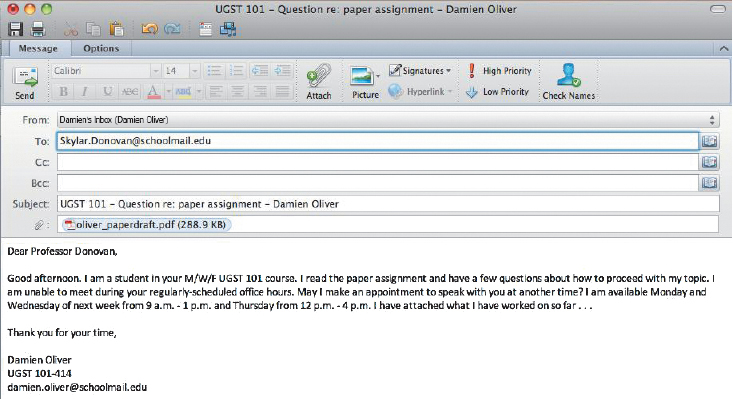Tech Tip: E-Mail Etiquette
TECH TIP E-MAIL ETIQUETTE
TECH TIP E-MAIL ETIQUETTE
Whether your class is online or face-to-face, at some point you will need to communicate with your instructor via e-mail. Writing e-mails to your instructors is different from writing e-mails to your friends. Keep the following points in mind:
1 THE PROBLEM
You need help with an assignment and have to send your professor an e-mail, but you’ve never sent an e-mail to any kind of teacher before.
2 THE FIX
Take a few minutes to figure out what exactly you need to ask, jot down your main points, and then construct a clear and concise e-mail.
3 HOW TO DO IT
Use a professional e-mail address. One like luvs2partee@partymail.com is not a good choice for correspondence with your instructor (or a potential employer, for that matter). Use a simple address that incorporates your name, like Damien.Oliver@schoolmail.edu, rather than one that hints at your weekend activities.
Make the subject line informative. Your instructor might receive hundreds of e-mails every day, and a relevant subject like “UGST 101—Question re: paper assignment-Damien Oliver” helps him or her prioritize and might lead to a faster response than a vague subject line. A subject line like “class” or “question” isn’t helpful, nor is a blank subject line.
Address your instructor with respect. Think about how your instructor refers to himself or herself in class, or look at your syllabus to see how your instructor signs his or her name. If the instructor uses “Doctor,” you should use “Doctor.” If you don’t know, you can never go wrong with “Professor.” Be sure to begin your e-mail message with a salutation like “Dear Professor.” “Hey” is not a salutation.
Sign every e-mail with your full name, course number, and e-mail address.
When attaching files, use a widely accepted file format like .doc, .docx, or PDF. Also, be sure to name your file something that helps your instructor know it’s yours, such as Oliver_paperdraft.pdf.
